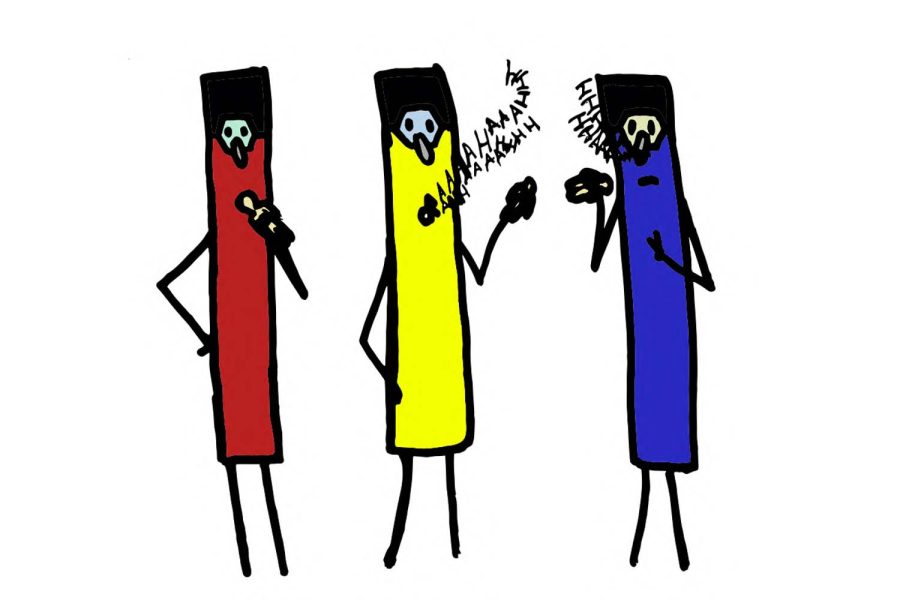E-cigarette usage in youth: how social pressure can affect decision-making
Credit: Thea Pipe
“Vapes Vaping People”
March 7, 2022
You’re walking into the bathroom between classes on a tiring Monday morning, trying to go fast enough to get in and out before class starts. You open the bathroom door to be surrounded by people talking and vaping in the middle of the room.
According to a poll taken by the CDC in 2020, over 19% of high school students reported current e-cigarette use. That’s over 3 million high school students in the United States who vape on a daily basis, using a variety of types of e-cigarettes.
For many high school students it’s incredibly easy to access things like this, with nothing really being done to stop them.
“I’ve thought about it a couple times and I think I’ll only do it through my teenage years. I feel like it’s a teen thing. I don’t think I’ll vape as an adult,” said a high school student, who chooses to remain anonymous due to the sensitivity of the topic.
Ads for e-cigarettes purposely target youth populations in their commercials by linking vaping to happiness, friendship, and success. They are also commonly marketed by stating the “benefits” of e-cigarettes over normal cigarettes.
Loy Norrix health teacher Franklin Sallis said, “Vaping is definitely addictive, especially when there is nicotine involved in a vape, and the addiction can definitely take its toll on someone physically and obviously mentally.”
Even though the companies claim vaping is better than smoking cigarettes, the damage of vaping is very similar to the damage from cigarettes. According to “Vaping: What You Need to Know”, by Lonna P. Gordon, MD, nicotine can be highly addictive and lead to developmental problems later in life. Most vapes have harmful metals and substances in them, such as lead and nickel or acrolein, a herbicide used to kill weeds. Vaping can cause lung disease, cardiovascular (heart) disease and have also been linked to cancer and asthma.
THC vapes, or marijuana vapes, are also commonly being used by highschoolers, though not as common as the regular vapes. THC vapes have similar effects and can be even more hazardous to youth health.
According to an article by University of Michigan nursing professor Carol Boyd titled, “Vaping marijuana associated with more symptoms of lung damage than vaping or smoking nicotine” Vaping marijuana is more harmful to respiratory systems than vaping nicotine and smoking cigarettes, and adolescents who were vaping marijuana were twice as likely to report “wheezing and whistling” in their chest.
Vaping is common in high schools and can be discussed casually among friends and peers, with no real fear of the long lasting effects the addiction could have on their health. It can be a lot easier for people to start vaping if they see people they are around and trust vaping. The bathrooms in high schools can be found flush full of students vaping in stalls or out in the open.
I was introduced to vaping at 10 or 11 from my brother’s friends: they thought it was funny when I vaped. They pressured me into it. I didn’t know it was wrong or anything.
— Charlie Doerschler
Loy Norrix freshman Charlie Doerschler said, “I was introduced to vaping at 10 or 11 from my brother’s friends: they thought it was funny when I vaped. They pressured me into it. I didn’t know it was wrong or anything.”
Peer pressure can also have an effect on students and their decisions. Even if someone isn’t directly pressuring someone else into vaping, it can still be classified as peer pressure.
According to Talk it Out, indirect peer pressure can just be someone being surrounded by people vaping, having friends who constantly vape, seeing other people who might be more prominent figures in your life vaping and the silent pressure of being around a bunch of people who are vaping.
“I have had students approach me and say that they have vaped because their friends vape, so I would say it’s an influence type situation,” Sallis said.
According to “Is Vaping a Gateway Drug”, vaping has been linked to teenagers using harder drugs later in life even if that might not be the case for everyone. Using addictive substances can lead to further addictive behaviors. It’s the belief that you’ll only do something once or twice, or only for a certain period of your life that can allow addiction to thrive.














destiney • Oct 10, 2023 at 1:57 pm
i loved the last message. ” Using addictive substances can lead to further addictive behaviors. It’s the belief that you’ll only do something once or twice, or only for a certain period of your life that can allow addiction to thrive.”